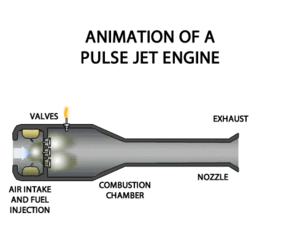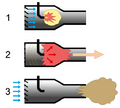Pulse jet engine facts for kids
A pulse jet engine is a special kind of internal combustion engine. It works by burning fuel in quick, short bursts, like tiny explosions. These bursts create a powerful jet of hot gas that pushes the engine forward. Think of it like a series of small, fast pushes instead of one continuous push.
Contents
How Pulse Jet Engines Work
A pulse jet engine is quite simple compared to other jet engines. It has a special tube or chamber. Air enters this chamber at the front. Fuel is then sprayed into the air.
The Combustion Cycle
Once the fuel and air mix, a spark plug ignites them. This causes a quick explosion, or "pulse," inside the chamber. The hot gases from this explosion rush out the back of the engine. This push of gas creates thrust, moving the engine forward.
After the hot gases leave, the pressure inside the chamber drops. This low pressure then pulls in more fresh air and fuel. The cycle then repeats very quickly, many times per second. This is why it's called a "pulse" jet – it works in rapid pulses.
Valved vs. Valveless Designs
There are two main types of pulse jet engines:
- Valved pulse jets: These have small, one-way valves at the front. These valves open to let air in and then close quickly when the explosion happens. This stops the hot gases from escaping out the front.
- Valveless pulse jets: These are even simpler. They don't have any moving parts or valves. Their shape is designed so that the hot gases mostly go out the back. A small amount of gas might escape the front, but most of the thrust still comes from the back.
A Brief History of Pulse Jets
The idea of a pulse jet engine has been around for a long time. Early designs were patented in the early 1900s.
World War II Use
The most famous use of a pulse jet engine was during World War II. The German V-1 flying bomb used a pulse jet engine called the Argus As 014. This engine was simple to build and allowed the V-1 to fly without a pilot. It made a very distinct buzzing sound, which earned it the nickname "buzz bomb."
Where Are Pulse Jets Used Today?
Today, pulse jet engines are not used in large airplanes. They are not very fuel-efficient and can be very noisy.
However, you might still find them in:
- Model aircraft: Hobbyists sometimes build and fly model planes powered by small pulse jets.
- Experimental projects: Some people use them for fun or to experiment with new designs.
- Heating systems: Believe it or not, some very efficient heating systems use a similar pulsing combustion idea.
Why Aren't They More Common?
While pulse jets are simple, they have some downsides.
- Noise: They are incredibly loud, much louder than other types of jet engines.
- Fuel efficiency: They use a lot of fuel for the amount of thrust they produce.
- Vibration: The pulsing action can cause a lot of vibration, which isn't good for aircraft or other machines.
Because of these reasons, more advanced and efficient engines like turbojets and turbofans are used for most modern aircraft.
Images for kids
-
Argus As 014 pulsejet engine of a V-1 flying bomb at the Royal Air Force Museum London
See also
 In Spanish: Pulsorreactor para niños
In Spanish: Pulsorreactor para niños





